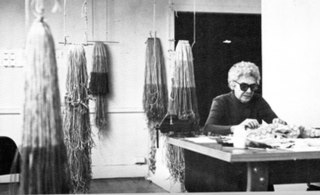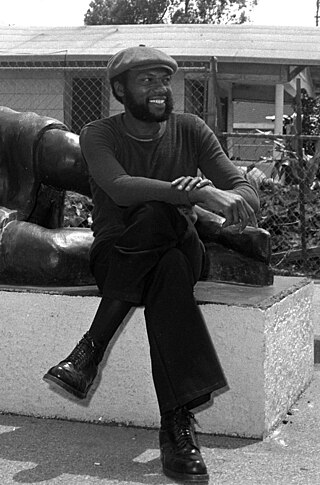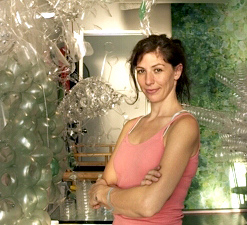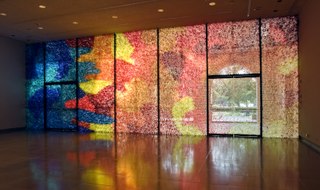Related Research Articles

New materials in 20th-century art were introduced to art making from the very beginning of the century. The introduction of new materials and heretofore non-art materials helped drive change in art during the 20th century. Traditional materials and techniques were not necessarily displaced in the 20th century. Rather, they functioned alongside innovations that came with the 20th century. Such mainstays as oil-on-canvas painting, and sculpting in traditional materials continued right through the 20th century into the 21st century. Furthermore, even "traditional" materials were greatly expanded in the course of the 20th century. The number of pigments available to artists has increased both in quantity and quality, by most reckoning. New formulations for traditional materials especially the commercial availability of acrylic paint have become widely used, introducing initial issues over their stability and longevity.

Within the 20th century, there came the use of plastics in art. In the latter half of the century, plastic technology advanced so that it was feasible for artists to start using plastic and acrylics as an artwork medium.

Louise Nevelson was an American sculptor known for her monumental, monochromatic, wooden wall pieces and outdoor sculptures. Born in the Poltava Governorate of the Russian Empire, she emigrated with her family to the United States in the early 20th century. Nevelson learned English at school, as she spoke Yiddish at home.

The universal recycling symbol is a symbol consisting of three chasing arrows folded in a Möbius strip. It is an internationally recognized symbol for recycling. The symbol originated on the first Earth Day in 1970, created by Gary Anderson, then a 23-year-old student for the Container Corporation of America. The symbol is not trademarked and is in the public domain. Many variations on the logo have been created since its creation.

Assemblage is an artistic form or medium usually created on a defined substrate that consists of three-dimensional elements projecting out of or from the substrate. It is similar to collage, a two-dimensional medium. It is part of the visual arts and it typically uses found objects, but is not limited to these materials.

Claire Zeisler was an American fiber artist who expanded the expressive qualities of knotted and braided threads, pioneering large-scale freestanding sculptures in this medium. Throughout her career Zeisler sought to create "large, strong, single images" with fiber.

Rasquachismo is a theory developed by Chicano scholar Tomás Ybarra-Frausto to describe "an underdog perspective, a view from "los de abajo" in working class Chicano communities which uses elements of "hybridization, juxtaposition, and integration" as a means of empowerment and resistance. Rasquachismo is commonly used to describe aesthetics present in the working class Chicano art and Mexican art movements which "make the most from the least." It has been described as a worldview, the "view of the underdog, which combines inventiveness with a survivalist attitude." Artists will oftentimes depict experiences of their own life in the "barrio" or the experiences of being Mexican and Chicano. This art movement has also been defined by artists and scholar Amalia Mesa-Bains "as a survivalist irreverence that functioned as a vehicle of cultural continuity."

Upcycling, also known as creative reuse, is the process of transforming by-products, waste materials, useless, or unwanted products into new materials or products perceived to be of greater quality, such as artistic value or environmental value.

John Outterbridge was an American artist and community activist who lived and worked in Los Angeles, California. His work explores the issues surrounding personal identity such as family, community and the environment through the use of discarded materials.
Chakaia Booker is an American sculptor known for creating monumental, abstract works for both the gallery and outdoor public spaces. Booker’s works are contained in more than 40 public collections and have been exhibited across the United States, Europe, Africa, and Asia. Booker was included in the 2000 Whitney Biennial, received a Guggenheim Fellowship in 2005, and an American Academy of Arts and Letters Award for Art in 2001. Booker has lived and worked in New York City’s East Village since the early 1980s and maintains a production studio in Allentown, Pennsylvania.
Michelle Stitzlein is an American artist who creates found object art / sculpture from recycled materials. She received a BFA in 1989 from the Columbus College of Art and Design. She and her husband Nathaniel Stitzlein founded Art Grange Studios in Baltimore, Ohio. At Art Grange they share their love of art with the public by offering tours of the studios as well as art workshops for all ages.

Plastics are a wide range of synthetic or semi-synthetic materials that use polymers as a main ingredient. Their plasticity makes it possible for plastics to be molded, extruded or pressed into solid objects of various shapes. This adaptability, plus a wide range of other properties, such as being lightweight, durable, flexible, and inexpensive to produce, has led to their widespread use. Plastics typically are made through human industrial systems. Most modern plastics are derived from fossil fuel-based chemicals like natural gas or petroleum; however, recent industrial methods use variants made from renewable materials, such as corn or cotton derivatives.

Nancy Rubins is an American sculptor and installation artist. Her sculptural works are primarily composed of blooming arrangements of large rigid objects such as televisions, small appliances, camping and construction trailers, hot water heaters, mattresses, airplane parts, rowboats, kayaks, canoes, surfboards, and other objects. Works such as Big Edge at CityCenter in Las Vegas contain over 200 boat vessels. Stainless Steel, Aluminum, Monochrome I, Built to Live Anywhere, at Home Here, at the Albright-Knox Art Gallery in Buffalo, contains 66 used aluminum boats and rises to a height of 30 ft.

Naomi Siegmann was an American artist who developed her career in Mexico, and was noted for her depiction of everyday objects outside their normal contexts. She began her career after she moved to Mexico with her family, learning to carve wood. She worked in this medium for about twenty years, before moving on to other materials, including recycled ones, in part due to her concerns for the environment. During her career, she had solo exhibits in Mexico and the United States, with participation in collective exhibits in these countries and Europe. She has been commissioned to create monumental works in Mexico and the United States. Her work has been recognized through membership in the Salón de la Plástica Mexicana.

Coleen Sterritt is an American sculptor known for abstracted, hybrid works made from a myriad of everyday objects and materials, combined in unexpected ways. Writers root her work in the tradition of post-minimalists Jackie Winsor, Eva Hesse and Nancy Graves, and assemblage artists such as Louise Nevelson, Robert Rauschenberg and Marisa Merz; she is sometimes associated with contemporaries Jessica Stockholder, Nancy Rubins, and Tony Cragg. Sculpture critic Kay Whitney suggests Sterritt's work "expands and reinterprets three of the most important artistic inventions of the 20th Century—collage, abstraction and the readymade"— in play with the traditions of Arte Povera bricolage and Surrealist psychological displacement. Curator Andi Campognone considers Sterritt one of the most influential post-1970s artists in establishing "the Los Angeles aesthetic" in contemporary sculpture, while others identify her as an inspiration for later West Coast artists creating hand-made, free-standing sculpture counter to trends toward interventions, public art and environmental works. Constance Mallinson writes that Sterritt's work "walks a line between charm and threat, the natural, the industrial and the hand fabricated, rejecting easy associations for complex reads." Los Angeles Times critic David Pagel calls it smart, funky and "subtly rebellious" in its refashioning of discarded material, dumpster finds, and art-historical lineages.

Aurora Robson is a Canadian-American artist who works in sculpture, installation, painting and collage, focusing on themes related to the environment.
The Modern and Contemporary Art Research Initiative is a program started by the Getty Conservation Institute (GCI). It began in 2007 in response to the variety of new materials and technologies being used by contemporary artists in their work, and the lack of known conservation treatments for these new materials. This area was seen as a gap in the field of conservation, but also posed unique challenges when considering the intention of the artist and the physical aging that his or her materials might endure. According to Thomas F. Reese, "Conservators...must enter into the critical spirit of the works themselves if they are to save and transmit not merely decontextualized fragments but their essence to the future."

Lisa Hoke is an American visual artist based in New York City and Hudson Valley, New York. She is known for colorful, immersive installations and abstract sculptures characterized by labor-intensive working processes and inventive use of repurposed consumer detritus as raw materials. Her work has often challenged notions of mastery, permanence and fixed meaning, embracing qualities such as contingency and transience. In early sculptures, she tested gravity and balance with intuitively arranged, tenuous suspensions; her later large-scale installations are created on-site and dismantled after exhibition, their materials saved for future re-use. Hoke first gained recognition in the 1990s as one of a number of sculptors that mined the domestic sphere for materials and ideas, in her case, mixing elements of formalism and postminimalism, Pop assemblage, and social, often feminist, commentary. In the 2000s, critics have compared the bright, swirling forms and textures of her installations to the varied surfaces of Antoni Gaudí and the sparkling patterns of Seurat and Klimt.
Evelyn Roth is a Canadian born interdisciplinary artist who has worked across the arts in textiles, sculpture, performance, dance and interactive fabric arts. Specialising in environmentally sensitive events, festivals, school programs and art gallery exhibits. Roth is based in the town of Maslin Beach, on South Australia's Fleurieu Peninsula.
Monami Ohno is a Japanese contemporary artist and sculptor. She became a breakout star in Japan and rose to prominence and limelight for her innovative out-of-the box thinking by applying a paradigm shift approach as she engaged in the process of moulding old amazon cardboard boxes into sculptures. She earned the nickname "cardboard girl" for her proactive thought provoking captivating idea by deploying discarded abandoned cardboard boxes to make artwork out of them.
References
- 1 2 "BOULAY, Diana (1946)". Dictionnaire historique de la sculpture québécoise au XXe siècle. Retrieved 2018-03-23.
- 1 2 France Filion, Le Droit, Aug. 2004
- 1 2 Paula Lindekugel-Willis, Minot Daily News, Dec. 1998
- ↑ "Art in America". 1988.
- ↑ "Boulay, Diana".